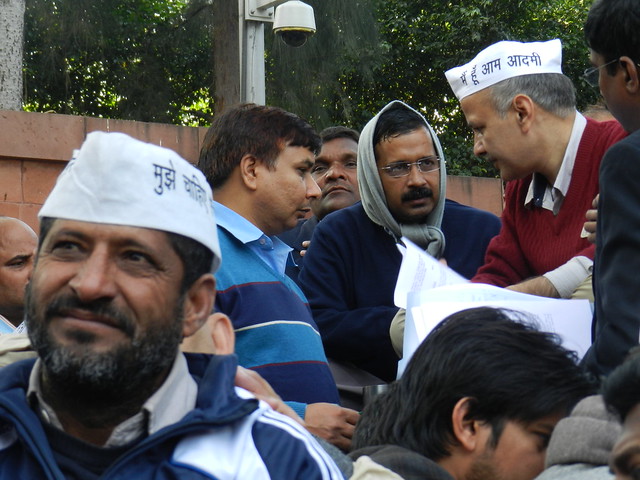By Hardeep S. Puri, IANS,
The enthusiasm and fanfare which greeted the establishment of the new political start-up, the Aam Aadmi Party (AAP), is fast evaporating. It has only itself to blame.
Social and political mobilisation against entrenched oppression and rampant corruption invariably impart an attractive flavour. Unless carefully crafted and managed, such protest, as history has repeatedly shown, invariably degenerates and results in unintended conclusions. A protest led by the Mothers’ Movement in Brazil in the early 1960s facilitated conditions for two decades of military rule.

Arvind Kejriwal
The much-heralded Arab Spring, which was expected to resonate on a Western democratic and pluralistic template, resulted in large-scale destabilisation, the use of force and intervention in Libya and continuing chaos in Syria.
Egypt perhaps provides the best example. The crowds gathered in Tahrir Square protesting against three decades of oppression by Hosni Mubarak resulted, in the first instance, in the election of the Islamic Brotherhood.The brotherhood was subsequently overthrown in a counter coup, again placing political power in the hands of a military ruler who could end up more authoritarian and repressive than Mubarak.
The use of a mob as an instrument in political negotiations is risky at the best of times. The mob led by the law minister of Delhi, Somnath Bharati, seeking vigilante-type justice, and the agitation mounted by the chief minister of Delhi, seeking either full statehood or control of the police, add a still more dangerous dimension because both were elected representatives who had taken the oath of office. They had sworn to operate within the coordinates of the law and the constitution.
It is unforgivable that the law minister asked the police to take unlawful action. If he does not know that residential premises cannot be searched without a warrant or that women cannot be arrested at night, at the very least, he should step down and be sent back to law school. The fact that he has now been identified by a Ugandan women as the person who led the mob that subjected her and others to inhuman treatment makes his continuation completely untenable.
The racial stereotyping and profiling of foreign nationals and subjecting them to vigilante-type justice are entirely condemnable. No civilised country can afford to behave in this manner. The Ministry of External Affairs did well in summoning African envoys to explain that these regrettable incidents were an aberration. Women’s organizations and the National Human Rights Commission should be allowed to do the rest. We should keep our fingers crossed that the misguided actions of the inexperienced political novices of AAP does not resonate internationally either in human rights fora or make our large overseas population vulnerable to similar reprisal action.
The attempt to justify the intellectual promiscuity of prominent AAP leaders as reflecting freedom of expression and internal party democracy borders on the absurd. Activist Kumar Vishwas apparently has a very poor view of women in general and those from a particular part of the country, in particular. Democracy in action outside Kerala Bhavan is now in full evidence.
The other party activist, Prashant Bhushan, wants to play football with national security by seeking a referendum on the presence of the armed forces in Jammu and Kashmir. This approach to dealing with problems of Maoist violence-affected areas also deserves honourable mention.
The middle class, by definition, is not revolutionary by nature. It is self-righteous, places a premium on expanding its rights and is easily encouraged by non-violent mobilisation against oppression and corruption. There is, however, another character of the middle class, more pronounced and more dominant.
It is fickle and displays an increasing propensity to quickly become disenchanted if the established order is threatened by chaos and anarchy. Arvind Kejriwal’s 36-hour dharna (sit-in) outside Rail Bhavan came close to doing precisely that. If Kejriwal had persisted with the agitation a little longer, it is entirely possible that the central government may have been left with no option but to use security forces to evict the squatters who, in this case, were led by the elected chief minister.
All this, however, raises a more fundamental question. The anarchist streak within the AAP has been in evidence for some time. What is the Congress party’s threshold for tolerance? It is, after all, Congress support which gives the AAP the oxygen to continue in power. Surely, to pull the plug now would be less costly than before this irrational outfit mounts another and more dangerous agitation. Equally, if the next agitation focusses on the 10 years of corruption by the Congress government in Delhi, the public opinion fallout for those supplying the oxygen will be more costly.
Any analysis of whether the resolution of the 36-hour crisis amounts to capitulation by a weak government scared of the mob or amounts to a victory by Kejriwal is entirely beside the point. This should be a wake-up call for all Indians because what has distinguished India from so many other countries in the world is the ability of our democracy to resolve differences in a peaceful and harmonious manner.
The ‘so-called’ practical solution that ended the 36-hour stand off may have saved the Republic Day celebrations but has dented the republic based on the rule of law. If all that was required was two policemen proceeding on leave, was this farcical grandstanding really necessary?
(Hardeep S. Puri is a retired diplomat who last served as India’s Permanent Representative to the United Nations in New York. The views expressed are personal. He can be contacted [email protected])

